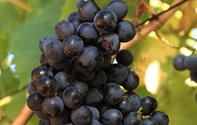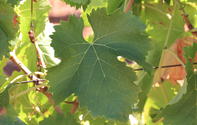Description
Grenache noir is a flexible grape variety, used for the production of red, sparkling, sweet and fortified wines. Its parentage is unknown.Origins
The variety seems to have originated in Cariñena, Aragon in the north east of Spain, from where it was spread to other lands in the then kingdom, including Sardinia, Sicily and Naples, as well as Roussilon and Corsica in France, which used to be part of the region.
By the 18th Century, the variety was well established in Languedoc, Southern Rhone and Provence.
The phylloxera epidemic of the late 19th Century also indirectly boosted plantings, as farmers tended to replace affected vineyards with the highly vigorous, easy to graft Grenache. The variety has over time become one of the most widely planted grapes, especially around the Mediterranean.
Other Names
Various synonyms exist, including Alicante in France, Granaccia in Italy and Garnacha in Spain.Production in South Africa
It is uncertain when Grenache arrived in South Africa. One theory is that James Busby, the Scotsman considered to be the “father” of the Australian wine industry, left cuttings here while sailing from Perpignan, France to Australia around the 1830s.
It was already well-established, when prof Abraham Izak Perold proved in 1907 that the Grenacha he imported from Rioja Spain was similar to the Grenache noir of Montpellier in France. Grenache blanc seemed to have arrived in South Africa in the 1970s, while Grenache Gris planting material only became available around the late-1990s.
Production Regions
Production is still quite limited in South Africa, but has been growing steadily over the past decade. Between 1999 and 2016, the area under Grenache blanc has increased from roughly 28 ha 110 ha, while the area under Genache noir increased from roughly 42 ha to over 340 ha.
The area under Grenache gris has remained low, going from nothing to just under 3 ha over the same time frame. All the Grenache gris vineyards are in the Paarl.
Grenache noir vineyards are found in all the wine producing regions of the country, with the Swartland and Paarl accounting for more than half of the area under production. The same holds true for Grenache blanc, except that it is not planted in the Northern Cape.
Growth and Ripening
Grenache noir is a moderate to vigorous grower, well-suited to warm dry climatic conditions. The variety has a high production potential, with yields averaging between 15 t/ha to 20 t/ha. Grenache noir grapes ripen mid-season, from the first half of March.
Berries and Leaves
Grenache noir berries are medium sized, round to oval shaped, with a dark pink colour that turns bluish black when ripe. The skin is tough and the flesh is juicy. The leaves are shiny with a yellowish green colour. It has a round to almost kidney shape and is mostly three lobed.

